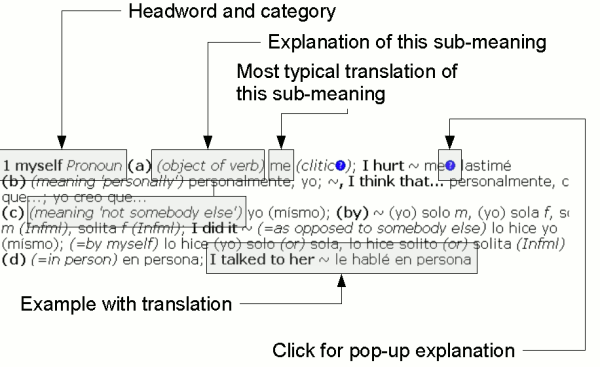How to use this dictionary:
interpreting dictionary definitions
When you look up a word, you'll generally get one or more definitions in the following format.
See below for a fuller description of the different parts:

- Headword and category
- The headword gives the basic form of the word. So if you look up a plural, then
the singular will generally be listed as the headword. The lexical category
(noun, adjective, pronoun) etc is intended to help you confirm that you've got the right
definition. It's not a strict theoretical statement about the status of that word.
- Explanation of sub-meaning
- The entries for many words are split into "shades of meaning". Each shade of meaning is
introduced by a letter: (a), (b) etc. In many cases, a brief summary of this shade of meaning is then given in
bracketed italics. Again, this is to help you locate the relevant part of the entry.
- Most typical translation
- At the beginning of the entry, following any explanation, is the typical translation or list
of typical translations for that shade of meaning. Sometimes the actual translation in some
specific circumstance may differ, and this is generally indicated by way of examples later
in the entry.
- Example with translation
- To help you find an idiomatic translation, example phrases with translations are often
provided. Translations of compounds are also provided where they have a fairly
"fixed" translation. For example, if you look up cafe (coffee), you'll
find the translation for cafe descafeinado (decaffeinated coffee, decaf).
- Pop-up explanations
- Where you see a question mark with a blue background, you can click for more information.
A pop-up window will appear giving a short grammar article or explanation of a tricky example. In this example,
clicking on the question mark will give you an explanation of why (among other things) the word
me appears before the verb.
 Site home
Site home
 Spanish-English dictionary
Spanish-English dictionary
 English-Spanish dictionary
English-Spanish dictionary


 Site home
Site home Spanish-English dictionary
Spanish-English dictionary English-Spanish dictionary
English-Spanish dictionary